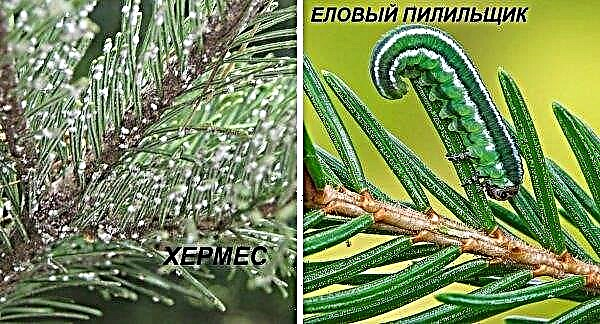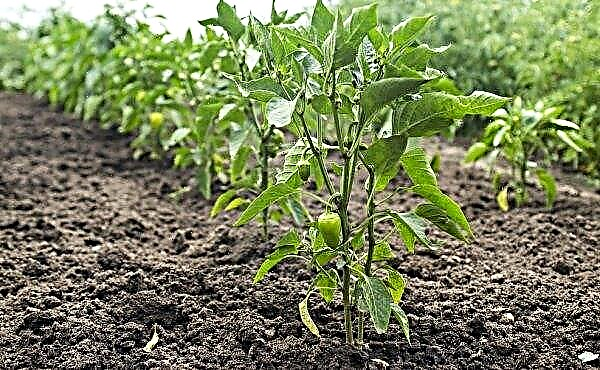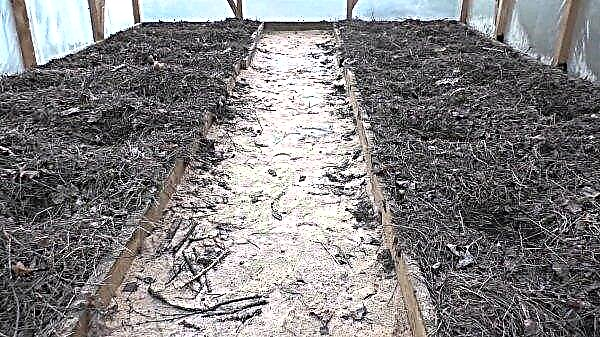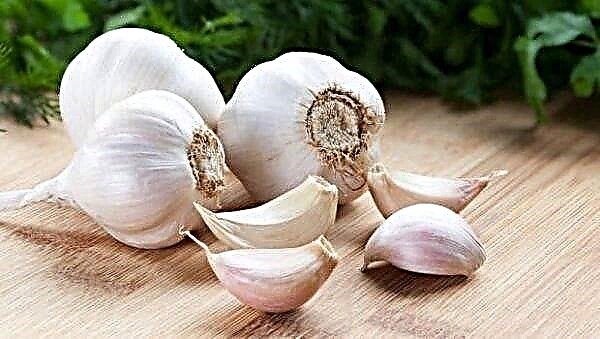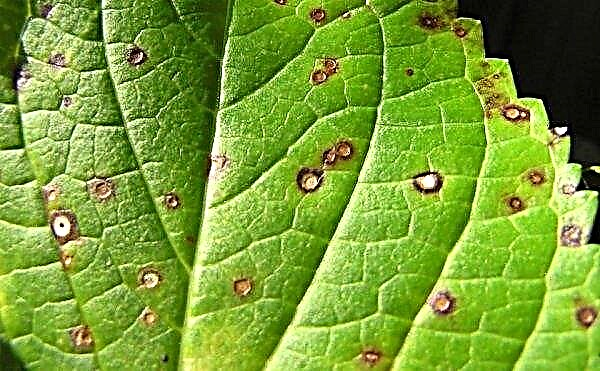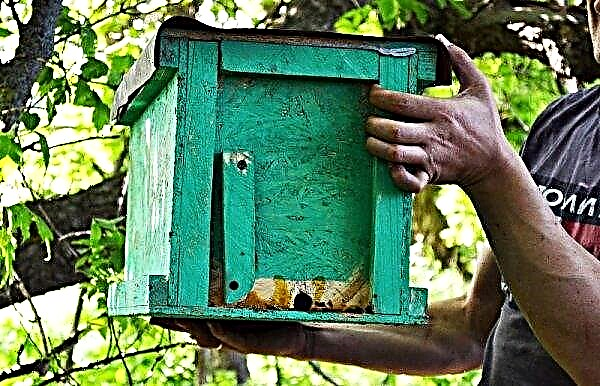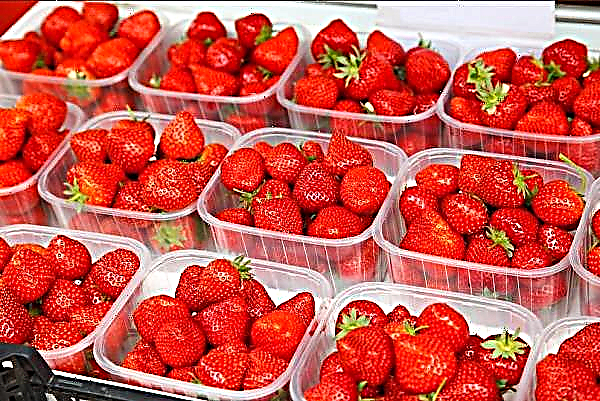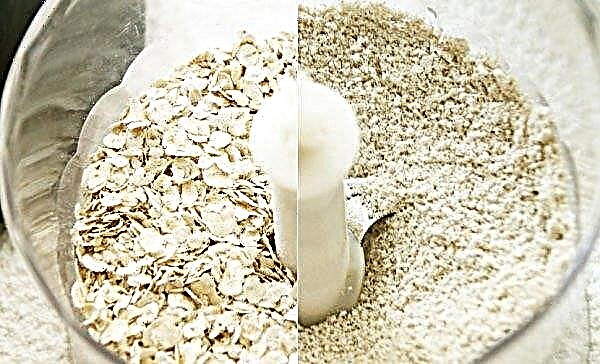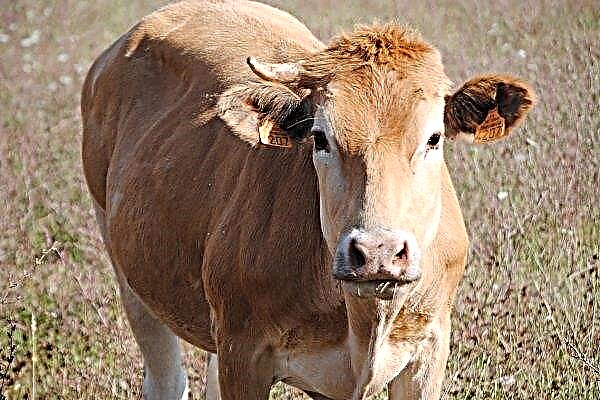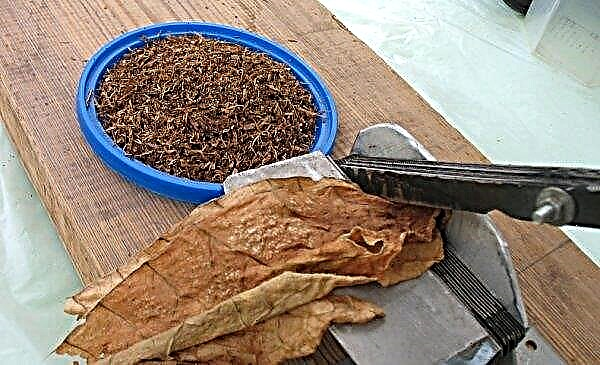The young, but already popular among domestic gardeners, the variety "Pink Paradise F1" in 2011 was recognized as one of the best varieties with pink fruits. It is unpretentious in leaving, and at the same time stably gives good harvests of large and tasty fruits.
Grade description
Variety "Pink Paradise F1" was bred by Japanese breeders in 2009.
Did you know? In the Spanish town of Bunyol, every year, at the end of summer, the international festival La Tomatina is held. During it, locals and tourists arrange a battle with tomatoes, using about 100 tons of fruits.
Tomatoes differ in the following characteristics:
- ripening in medium terms - the first fruits are formed 116–119 days after emergence;
- tall and indeterminate bushes - reach a height of 2 m, are subject to mandatory formation;
- green leaves, medium in size;
- the first inflorescence is tied over the 9th leaf;
- fruits of flat round shape, slightly ribbed;
- the skin of tomatoes is dense, glossy;
- the color of the fruit is pink;
- the average weight of the fruit is 150-200 g;
- the yield of the variety is high: 4 kg per 1 m²;
- 4-6 fruits are formed on one brush;
- pulp fleshy, juicy, sweet;
- fruits are resistant to cracking;
- tomatoes are suitable for eating fresh, for processing and preservation;
- bushes are resistant to fungal infections, verticillus and fusarium wilt, nematode;
- characterized by good keeping quality;
- perfectly maintain appearance after transportation;
- can be grown in open ground and in a greenhouse, the best conditions are under the film.

Advantages and disadvantages
- The strengths of the Pink Paradise variety include:
- high level of productivity;
- friendship shoots;
- excellent taste and marketability of the fruit;
- resistance to temperature extremes;
- good resistance to fungal diseases, verticillin wilt, fusarium, tobacco mosaic virus, root nematode.
- The variety has a number of disadvantages:
- intolerance to frost;
- the need for regular bush formation and tying;
- lack of ability to propagate with their own seeds;
- difficulty in growing on open beds.
Self-growing seedlings
Like most varieties, Pink Paradise F1 is best planted with seedlings - this is how you can achieve strong, healthy plants and the greatest yield. However, seedlings should be planted in a timely and correct manner. Its cultivation takes place over 1.5–2 months in indoor conditions, after which grown and stronger seedlings are transplanted to a garden bed or in a greenhouse.
Sowing dates
The optimal seed planting period is the beginning of March. When planting at such times, it will be necessary to move the sprouts to a permanent place in April-May.
The soil
Soil for germinating seedlings can be purchased at the store. Peat substrate is best suited for these purposes.
Also, if possible, you can mix it yourself from these ingredients:
- peat - 2 parts;
- turf land - 1 part;
- humus (compost) - 1 part;
- sand - 0.5 parts.
Regardless of whether the soil substrate is made with your own hands or purchased in a store, you need to process it:
- Disinfect by watering with a weak (pink) potassium permanganate solution or with Fitosporin; can also be calcined in the oven at a temperature of 70–90 ° C or in the microwave for 10–20 minutes at medium power.
- Moisturize liberally.
- To sustain in room conditions throughout the day.

Capacity for growing
For germinating seedlings, a long box made of wood or plastic, 200-gram plastic, cardboard, peat cups, cassettes are suitable. It is believed that stronger seedlings can be grown in separate containers.
Seed preparation
Since the Pink Paradise variety is hybrid, the seeds are purchased annually in the store. They do not require disinfection, as the manufacturer has already taken care of the treatment of seed material. You can soak them in a growth stimulator for 10-12 days - this will allow them to germinate faster.
See also indeterminate tomatoes such as:
Sowing seeds
To successfully sprout seedlings, you need to use the following technology:
- Make grooves in the soil with a depth of 1-1.5 cm.
- Put tweezers in them for 1-2 seeds at a distance of 1 cm.
- Fill the soil with a 0.5-centimeter layer.
- To water.
- Cover with foil or glass.

Seedling Care
For seedlings you need to create the following conditions:
- air temperature - + 22–25 ° С;
- air humidity - 60–70%;
- bright lighting;
- daylight hours - 14–16 hours (if necessary, organize artificial lighting).
Most often, seedlings are grown on window sills.
Caring for seedlings involves the following procedures:
- regular watering of the substrate;
- daily airing;
- pick;
- fertilizer application;
- hardening (for landing on an open bed).
Seedlings are watered with a spray gun, this will protect the seeds from leaching from the soil and not damage the fragile sprouts. It is necessary to water only with warm, settled, rain or filtered water. Watering is carried out every 7-10 days. Airing is necessary to give an influx of fresh air and to protect plantings from the development of fungal infections. After the appearance of the first sprouts - approximately 3-4 days after sowing - you need to open them. When 1–2 true leaves are formed on the seedlings, they must be dived — transplanted into different peat pots or tablets with a nutritious substrate, Signor Tomato fertilizer (3 tbsp. Per 5 l of soil) or full mineral top dressing (1 tbsp. on 5 l of soil). After picking, the sprouts need to continue to be moistened and sprayed.
When 1–2 true leaves are formed on the seedlings, they must be dived — transplanted into different peat pots or tablets with a nutritious substrate, Signor Tomato fertilizer (3 tbsp. Per 5 l of soil) or full mineral top dressing (1 tbsp. on 5 l of soil). After picking, the sprouts need to continue to be moistened and sprayed.
Recommended air temperature during the day - no lower than + 18 ° С, at night - no lower than + 12 ° С. After 14 days after diving, planting should be fertilized with mineral additives - Kemira Plus, Agricola, or other complex fertilizers intended for seedlings. A few days before the plan to move the sprouts to a permanent place, stop watering them.
Seedling hardening
When cultivated in open beds 7-10 days before the planned date of transfer of sprouts to the soil, it is necessary to begin hardening of seedlings - on warm days, take out pots in fresh air, starting from 5 minutes a day. Every day, the duration of the hardening procedure will need to be increased, bringing to 40-60 minutes. Such manipulations will strengthen the immunity of tomato bushes and their resistance to diseases and pests.
Planting seedlings in a permanent place
A great influence on the yield of tomatoes has a place on which they are cultivated, and the soil. Ground preparation must begin in the fall. In the spring, a month before planting, it is disinfected and fed. At this time, it is best to introduce organic matter - humus or compost with wood ash. Planting in the greenhouse is carried out in late May, in open ground - in early June. By this time, the sprouts will reach a height of 20-30 cm.
The soil should warm up well, and the night frost should pass. Daytime temperature should be set at + 22–25 ° С, nighttime - not lower than + 15 ° С. In the earth they make holes slightly larger than an earthen lump. Peat pots or tablets with sprouts are simply placed in them and sprinkled with earth. Plastic, cardboard glasses are cut with scissors, the sprouts are removed together with an earthen lump and moved to the landing hole. A few hours before this, they need to be well watered.
Important! Tomatoes should be planted on the beds where cauliflower and white cabbage, pumpkin and leguminous crops, root crops and onions grew earlier. Planting after potatoes, peppers, eggplants is not recommended.
The landing site is chosen open to the rays of the sun, but sheltered from the winds. In sunny weather, seedlings are moved in the evening, in the absence of sun - in the morning. Recommended planting patterns - 40 x 50, 50 x 60 cm. Sprouts are placed in a hole at an angle of 45 °, making sure that neither the leaves nor the trunk come into contact with the ground. Planting is abundantly watered. Since Pink Paradise tomatoes give tall bushes and tying is a must, immediately after planting, set a trellis or high stakes. Upon reaching a height of half a meter, the bushes are tied to them. At first, tomatoes planted in open ground should be covered with a film or covering material such as “Spanbond”, “Lutrasil”.
Since Pink Paradise tomatoes give tall bushes and tying is a must, immediately after planting, set a trellis or high stakes. Upon reaching a height of half a meter, the bushes are tied to them. At first, tomatoes planted in open ground should be covered with a film or covering material such as “Spanbond”, “Lutrasil”.
Features of outdoor care
So that the tomatoes are not sick and show the highest productivity, they need to be taken care of.
Standard tomato care procedures include:
- watering;
- fertilizer application;
- stepchildren;
- garter;
- loosening the soil;
- weeding;
- hilling;
- mulching.
Watering
Tomatoes require moderate watering. For the first time after planting, they are watered after 10-12 days; the moisture that came during humidification during planting is entirely enough for just such a period. Subsequently, tomato bushes are watered 1-2 times a week. At the same time, they control that the drops do not fall on the stems and leaves - this can cause burns. You need to nourish the plants with moisture in the evening, after sunset. It is better to organize drip irrigation - so moisture will be delivered directly to the roots. Water with this method will be consumed much less. Before the onset of the flowering phase, approximately 4 liters of water will be required to moisten 1 m², about 12 liters during flowering and the formation of ovaries.
You need to nourish the plants with moisture in the evening, after sunset. It is better to organize drip irrigation - so moisture will be delivered directly to the roots. Water with this method will be consumed much less. Before the onset of the flowering phase, approximately 4 liters of water will be required to moisten 1 m², about 12 liters during flowering and the formation of ovaries.
Important! Watering is carried out only with warm water, heated to a minimum of + 20 ° C.
In the fruiting phase, watering should be reduced so that the fruits do not become watery and do not give cracks. Since tomatoes do not suffer either a shortage or an excess of moisture, you need to water them sparingly. To find out if the plants are watered enough, gardeners use the following method: they compress a lump of soil isolated from a depth of 10 cm. If it is well molded into a mold and decays, then watering is sufficient.
Top dressing
One of the main factors that directly affects the yield of tomatoes is the regular application of fertilizers. For the season you need to make 3-4 feeding. You can use the following recommendations:
You can use the following recommendations:
| Term | Fertilizer |
| 14–20 days after seedlings are moved to the ground | 40 g of phosphorus-containing fertilizers + 15 g of potash + 25 g of nitrogen + 10 l of water. The flow rate of the working fluid is 1 liter per 1 bush. |
| During the appearance of flowers | 0.5 l mullein or bird droppings + 1 tbsp. potassium sulfate + 10 l of water or nitrophosphate, "Solution", "Kemira universal". |
| During the formation of the ovary | infusion of wood ash (2 liters per 10 liters of hot water) + 10 g of boric acid. |
| In the phase of mass fruiting | 2 tbsp. superphosphate + 1 tbsp. sodium humate + 10 l of water. |
In addition to organics and mineral additives, tomatoes are fed with yeast, herbal infusions. They are applied in a non-root way. For the preparation of yeast bait using 10 g of dry yeast, 0.5 l of wood ash, 5 tbsp. sugar, 10 liters of water. Such fertilizer is sprayed onto leaves and stems during budding and blooming of the first flowers.
Shaping and tying a bush
As already noted, pinching and tying the bush are mandatory for the indeterminate Pink Paradise hybrid. These procedures will increase the level of productivity, protect the stems from breakage and prevent the development of diseases. The stalk forms many side shoots - stepsons. Their uncontrolled appearance leads to the following:
Their uncontrolled appearance leads to the following:
- plantings become too thick;
- air cannot circulate normally in them;
- they do not get enough light;
- the fruits are small and ripen late.
Important! If you grow a Pink Paradise hybrid in 2 stems, then it will bear fruiting 7-14 days later.
In addition to removing the side shoots, the lower leaves, which are in contact with the soil, are also torn off. This procedure avoids the development of fungal diseases.
Soil care
Soil care involves:
- loosening;
- mulching;
- weeding weeds;
- hilling.
It will be necessary to loosen the soil after watering and rainfall. This procedure improves the moisture and air permeability of the soil, as a result of which water and oxygen are better delivered to the root system. Loosening the soil in the near-stem zone is done carefully so as not to damage the roots. It is combined with hills and weeds. For the first time, the earth is loosened to a depth of 8–12 cm. Later on, more surface loosening is used - to a depth of 4–5 cm. For a season it is necessary to produce at least 3-4 cultivations. Hilling is optional. Some gardeners claim that it is necessary and useful, with the help of it it is possible to enrich the soil with oxygen, strengthen the rhizome, and contribute to the formation of additional roots. Others consider it a waste of time and energy. If you are of the opinion that you need to hone tomatoes, then you need a chopper or trident rake.
For a season it is necessary to produce at least 3-4 cultivations. Hilling is optional. Some gardeners claim that it is necessary and useful, with the help of it it is possible to enrich the soil with oxygen, strengthen the rhizome, and contribute to the formation of additional roots. Others consider it a waste of time and energy. If you are of the opinion that you need to hone tomatoes, then you need a chopper or trident rake.
They sprinkle the soil with a hill to the stem. As necessary, the aisles are cleaned of weeds - they are removed along with the roots. Optionally, but preferably mulch the soil. The mulching procedure allows you to limit the growth of weeds and save moisture in the soil. For this purpose, mowed grass, peat or straw are used.
Did you know? Pink tomatoes are healthier than red tomatoes because they contain 3 times more dry matter, pectin, vitamin C, carotene, lycopene, and selenium. Regular consumption of pink tomatoes by men by 75% reduces the risk of prostatitis.
So, it is better to purchase Pink Paradise F1 seeds to those farmers who prefer to grow tomatoes in greenhouses, in lightweight constructions under a film. The hybrid is also suitable for open ground, however, it will require a lot of care - mandatory garter and bush formation. These tomatoes are delicious, appetizing in appearance, able to lie for a long time, do not lose their presentation in transit.

